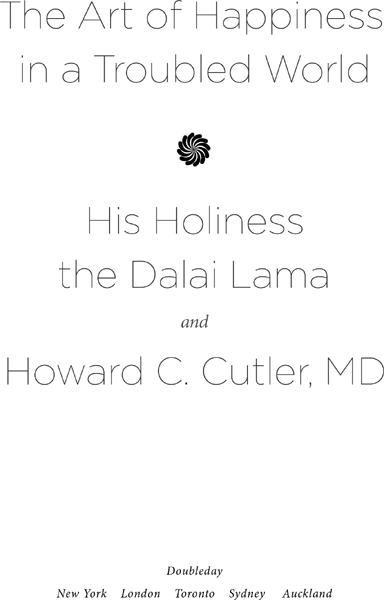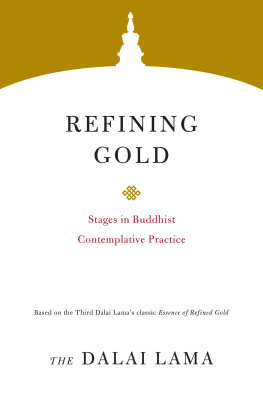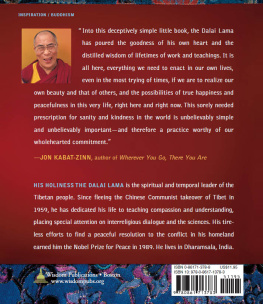Dalai Lama - The Art of Happiness in a Troubled World
Here you can read online Dalai Lama - The Art of Happiness in a Troubled World full text of the book (entire story) in english for free. Download pdf and epub, get meaning, cover and reviews about this ebook. year: 2009, genre: Religion. Description of the work, (preface) as well as reviews are available. Best literature library LitArk.com created for fans of good reading and offers a wide selection of genres:
Romance novel
Science fiction
Adventure
Detective
Science
History
Home and family
Prose
Art
Politics
Computer
Non-fiction
Religion
Business
Children
Humor
Choose a favorite category and find really read worthwhile books. Enjoy immersion in the world of imagination, feel the emotions of the characters or learn something new for yourself, make an fascinating discovery.

- Book:The Art of Happiness in a Troubled World
- Author:
- Genre:
- Year:2009
- Rating:5 / 5
- Favourites:Add to favourites
- Your mark:
- 100
- 1
- 2
- 3
- 4
- 5
The Art of Happiness in a Troubled World: summary, description and annotation
We offer to read an annotation, description, summary or preface (depends on what the author of the book "The Art of Happiness in a Troubled World" wrote himself). If you haven't found the necessary information about the book — write in the comments, we will try to find it.
The Art of Happiness in a Troubled World — read online for free the complete book (whole text) full work
Below is the text of the book, divided by pages. System saving the place of the last page read, allows you to conveniently read the book "The Art of Happiness in a Troubled World" online for free, without having to search again every time where you left off. Put a bookmark, and you can go to the page where you finished reading at any time.
Font size:
Interval:
Bookmark:



CONTENTS
PART ONE
Chapter 1
Chapter 2
Chapter 3
Chapter 4
Chapter 5
PART TWO
Chapter 6
Chapter 7
Chapter 8
Chapter 9
PART THREE
Chapter 10
Chapter 11
Chapter 12
Chapter 13
Chapter 14
Chapter 15

AUTHORS NOTE
In this book, extensive conversations with the Dalai Lama have been recounted. The Dalai Lama generously allowed me to select whatever format for the book I felt would most effectively convey his ideas. I felt that the narrative format found in these pages would be most readable and at the same time impart a sense of how the Dalai Lama incorporates his ideas in his own daily life. With his approval, I organized this book according to subject matter, and in doing this I have chosen to combine and integrate material that may have been taken from several different conversations. The Dalai Lamas interpreter, Dr. Thupten Jinpa, kindly reviewed the final manuscript to assure me that there were no inadvertent distortions of the Dalai Lamas ideas as a result of the editorial process.
A number of case histories and personal anecdotes have been presented to illustrate the ideas under discussion. In order to maintain confidentiality and protect personal privacy, in every instance (unless otherwise indicated) I have changed names and altered details and other distinguishing characteristics to prevent identification of particular individuals.

INTRODUCTION
A while back, I was invited to Australia to deliver the opening keynote address at an international conference on human happiness. This was an unusually large event, which brought together fifty leading experts from around the world to speak about happiness, thousands of attendees, and even the Dalai Lama, who appeared on the second day as the featured speaker.
With so many professional colleagues gathered in one spot, there was plenty of lively discussion on a wide range of topics. During a lunch break, I overheard several colleagues arguing about the merits of some recent articles in the Australian newspapers, touching on a debate going on in positive psychology circles. Positive psychology is a new branch of psychology often referred to as the science of human happiness. The question being debated was: If the goal is to increase human happiness, which is the better approachto focus on inner development or social welfare? In other words, should efforts be devoted primarily to developing techniques that individuals can practice to increase personal happiness, or should we focus on improving social conditions, creating conditions that allow the members of a society to thrive and result in greater happiness for the population as a whole?
It seemed that the debate could be quite contentious at times. Some championing the social approach were characterizing positive psychology, which largely focused on finding effective methods of increasing personal happiness, as little more than another self-indulgent pop-psychology fad, concerned only with a self-centered pursuit of personal gratification. Of course the positive psychology camp had some powerful arguments in rebuttal. While not denying that having ones survival needs met was a prerequisite for happiness, they went on to point out that since happiness is a subjective state, involving an individuals attitudes, perceptions, emotions, and so on, ultimately it was necessary to focus on a persons inner state, on an individual level, to increase happiness. In addition, addressing the claims that working on increasing personal happiness is a self-absorbed, selfish pursuit, they pointed to studies showing that increasing personal happiness makes an individual more charitable, more giving, more willing to reach out and help others, and it is unhappy people who are more self-focused and selfish.
Until that moment I had been unaware of the extent of this debate, which in a way could be boiled down to a fundamental question of ones basic orientation: Me or We? So when I first heard people debating this issue, I was riveted. As it turned out, the Dalai Lama and I had spoken about that very same issue during the course of some recent discussions we were having about the relationship between the individual, the greater society, and human happiness, seeking to answer questions such as: What is the effect of society on an individuals happiness? If societal problems undermine our happiness, what can we do about it? What is an individuals responsibility to try to bring about social change? And how much can a single individual do, anyway?
Those discussions, which include some of the conversations chronicled in this book, were part of an ongoing dialogue about human happiness that we originally began in 1993. In order to put these conversations in the proper context, I think it will be helpful to step back and briefly review the history of the Art of Happiness book series, and the radical changes that have taken place within both the scientific community and the general public with regard to our perception and understanding of happiness.
It was the beginning of the 1990s when I first began to think about collaborating with the Dalai Lama on a book about happiness. The Dalai Lama had already written three dozen books by that time, but since they appealed primarily to students or practitioners of Buddhism, his books had failed to find a wide readership among a general Western audience. I had known the Dalai Lama for about a decade by then, enough time to realize that he had much wisdom to offer non-Buddhists as well as Buddhists. So, I began to envision a book written for a general Western audience, distilling the essential principles that had enabled him to achieve happiness. By focusing on the practical application of his ideas in daily life and by framing his views within the context of Western science and psychology, I hoped to ultimately come up with an effective approach to finding happiness that combined the best of East and West. The Dalai Lama readily agreed to my proposal, and we eventually began work on the project in 1993, during his first visit to my home state of Arizona.
Inspired and excited by the project, I decided to temporarily give up practicing psychiatry in order to devote my full attention to writing the book. I estimated that it would take six months to complete the book, and with the Dalai Lama as a coauthor, I was certain Id have my choice of the top publishing companies.
I miscalculated. Five years later I was still working on the book and still adding to the thick, demoralizing, ever-growing stack of rejection letters on my deskletters from literary agents and publishers who were uniformly convinced that there was no mainstream audience for books by the Dalai Lama, no market for a collaboration between him and a Western psychiatrist, and no public interest in the subject of happiness. With my financial resources depleted, it seemed I had few options left, and I was just on the verge of self-publishing a few copies of the book and returning to the practice of psychiatry when I had a stroke of luck at last. It was right at that point that an offhand remark made by the mother of a close friend to a stranger on a New York subwaya stranger who turned out to be in the publishing industryinitiated an unlikely series of connections that finally led to securing an agent and mainstream publisher. And so it was in 1998, with a small first printing and modest expectations,
Font size:
Interval:
Bookmark:
Similar books «The Art of Happiness in a Troubled World»
Look at similar books to The Art of Happiness in a Troubled World. We have selected literature similar in name and meaning in the hope of providing readers with more options to find new, interesting, not yet read works.
Discussion, reviews of the book The Art of Happiness in a Troubled World and just readers' own opinions. Leave your comments, write what you think about the work, its meaning or the main characters. Specify what exactly you liked and what you didn't like, and why you think so.














